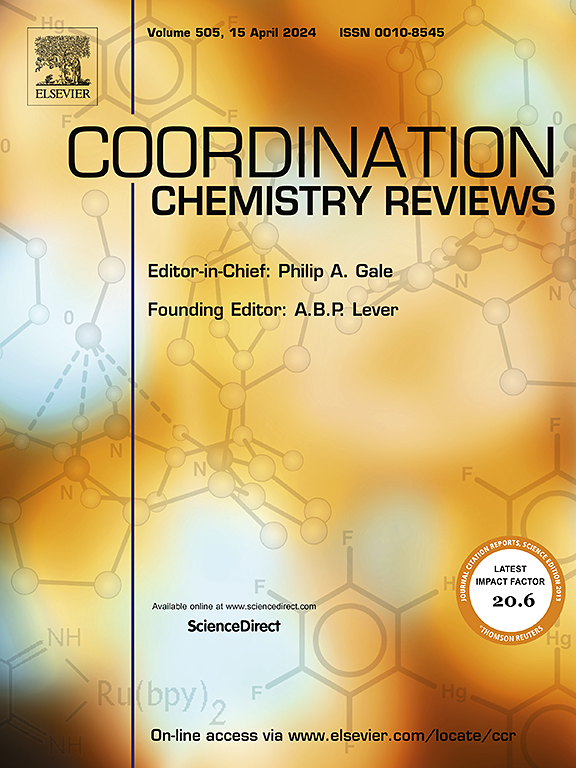Catalyst design strategies for highly efficient CO2 electroreduction
IF 20.3
1区 化学
Q1 CHEMISTRY, INORGANIC & NUCLEAR
引用次数: 0
Abstract
The massive emission of CO2 has caused significant environmental problems, including global warming, disruption of carbon balance, and threats to human health. Electrocatalytic CO2 reduction reaction (CO2RR) that operates under mild conditions to produce small-molecule fuels and value-added chemical products, is viewed as one of the most promising strategies for mitigating atmospheric CO2 concentrations and restoring the carbon cycle equilibrium. Recent achievements in the development of high-performance electrocatalysts have promoted the practical application of CO2RR. In this review, the mechanism pathways for forming C1, C2, and C2+ products, as well as the crucial parameters for evaluating CO2RR performance are introduced first. Then, the factors affecting CO2RR performance, such as electrolyzer devices and electrolytes, are also briefly discussed. Most importantly, various strategies that were developed for boosting the performance of electrocatalysts are summarized from the perspective of different products. Furthermore, the effects of these strategies on the active site and the reaction environment are discussed in detail. Finally, the future challenges and perspectives, including design of high-efficient, highly selective and robust CO2RR electrocatalysts, deeper understanding of structure-performance relationship, insights into the CO2RR mechanism, and integrating or coupling CO2RR with other reactions (e.g. N2 or NO3− or SO32‐ electroreduction, biomass electrooxidation, etc.) or biological fermentation to produce high-value heteroatom-containing or long-chain organic compounds or improve the overall energy and economy efficiency of CO2 electrolysis. This review offers valuable insights into methods for developing proper electrocatalysts to steer the reaction pathways toward CO2RR, and suggests future directions and perspectives on CO2RR field.

高效CO2电还原催化剂设计策略
二氧化碳的大量排放造成了严重的环境问题,包括全球变暖、碳平衡被破坏以及对人类健康的威胁。电催化二氧化碳还原反应(CO2RR)在温和的条件下运行,生产小分子燃料和增值化学产品,被认为是减少大气二氧化碳浓度和恢复碳循环平衡的最有前途的策略之一。近年来高性能电催化剂的研究成果促进了CO2RR的实际应用。本文首先介绍了C1、C2和C2+产物的形成机理、途径以及评价CO2RR性能的关键参数。然后,简要讨论了影响CO2RR性能的因素,如电解槽装置和电解液。最重要的是,从不同产品的角度总结了提高电催化剂性能的各种策略。此外,还详细讨论了这些策略对活性位点和反应环境的影响。最后,展望了未来的挑战和展望,包括设计高效、高选择性和稳健的CO2RR电催化剂,更深入地了解CO2RR的结构-性能关系,深入了解CO2RR的机理,以及将CO2RR与其他反应(如N2或NO3−或SO32‐电还原、生物质电氧化等)整合或耦合。等)或生物发酵生产高价值的含杂原子或长链有机化合物,或提高CO2电解的整体能源和经济效率。本文为开发合适的电催化剂来引导CO2RR的反应途径提供了有价值的见解,并对CO2RR领域的未来发展方向和展望提出了建议。
本文章由计算机程序翻译,如有差异,请以英文原文为准。
求助全文
约1分钟内获得全文
求助全文
来源期刊

Coordination Chemistry Reviews
化学-无机化学与核化学
CiteScore
34.30
自引率
5.30%
发文量
457
审稿时长
54 days
期刊介绍:
Coordination Chemistry Reviews offers rapid publication of review articles on current and significant topics in coordination chemistry, encompassing organometallic, supramolecular, theoretical, and bioinorganic chemistry. It also covers catalysis, materials chemistry, and metal-organic frameworks from a coordination chemistry perspective. Reviews summarize recent developments or discuss specific techniques, welcoming contributions from both established and emerging researchers.
The journal releases special issues on timely subjects, including those featuring contributions from specific regions or conferences. Occasional full-length book articles are also featured. Additionally, special volumes cover annual reviews of main group chemistry, transition metal group chemistry, and organometallic chemistry. These comprehensive reviews are vital resources for those engaged in coordination chemistry, further establishing Coordination Chemistry Reviews as a hub for insightful surveys in inorganic and physical inorganic chemistry.
 求助内容:
求助内容: 应助结果提醒方式:
应助结果提醒方式:


